This blog post is the third in a series that explores the Things Unbound project, a partnership funded by UKIERI and the British Academy (2014-2017), between the School of Museum Studies at the University of Leicester, UK (led by Professor Sandra Dudley) and the National Museum Institute in New Delhi, India (led by Professor Manvi Seth). The research took place in sites including: in India at Maharaja Sawai Man Singh II Museum, or City Palace Museum in Jaipur, Rajasthan, and Thiksey Monastery in Ladakh; and in the UK at Ely Cathedral in Cambridgeshire, and Harborough Museum at Market Harborough in Leicestershire.
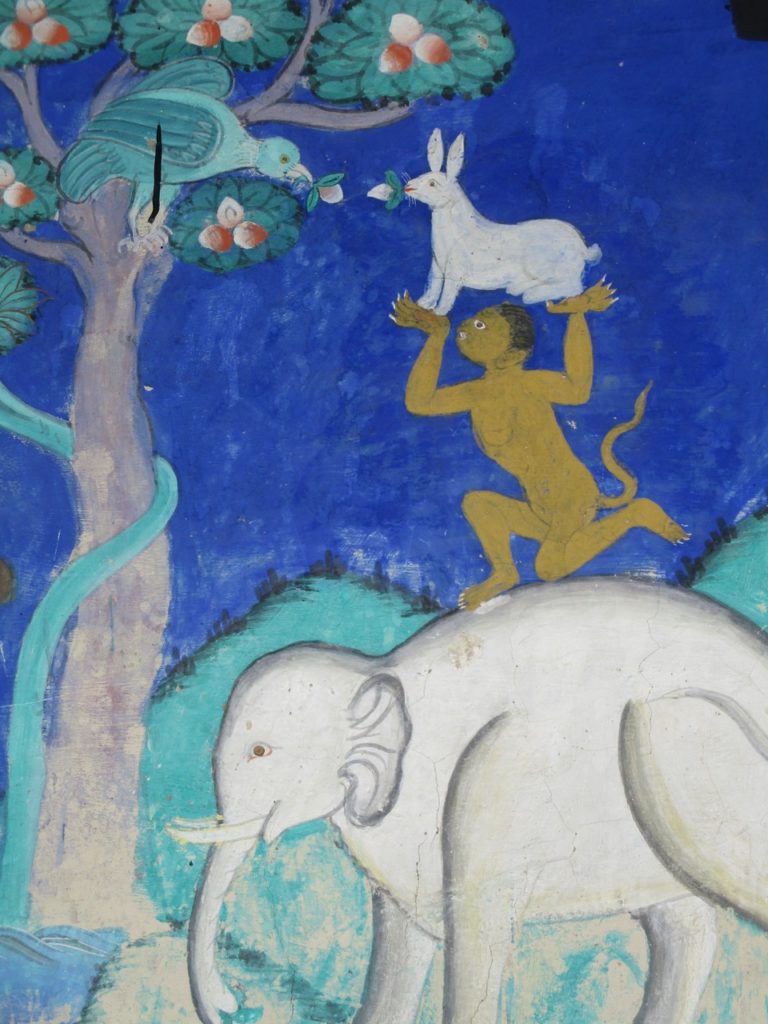
A friendship tale of the elephant, monkey, rabbit and bird, helping each other to get fruit
Here, I focus on work we undertook in the incredible mountainous region of Ladakh, certainly the most remote place I have ever visited, situated in the northernmost part of India, with Pakistan to its west, and China to its east. It is the first time I have written publically about this phase of the research and my experiences in Ladakh, not least because I went while working in a (different) full-time job so have had little time to reflect and write, but perhaps also as my impressions and experience, there were so moving – ineffable? – that it has since been difficult to put things into words. I cannot wait to return: and to return ‘better’, more mindful of who I am and the impact I have both as a researcher and particularly as a traveler in that place. The very fact that it has taken me so long to write about these experiences means that there is now a distance, less immediacy (less validity?) in my research – but also – and because of this – there has been more time for absorption, reflection and mulling things over. I recently read Will Buckingham’s book, Stealing with the Eyes, which is both a wonderful travellers’ tale – but it also describes his growing concerns with the activities of the anthropologist. I have written more on this on my own blog here – but it has certainly made me reflect on my role as a researcher in an unfamiliar environment.
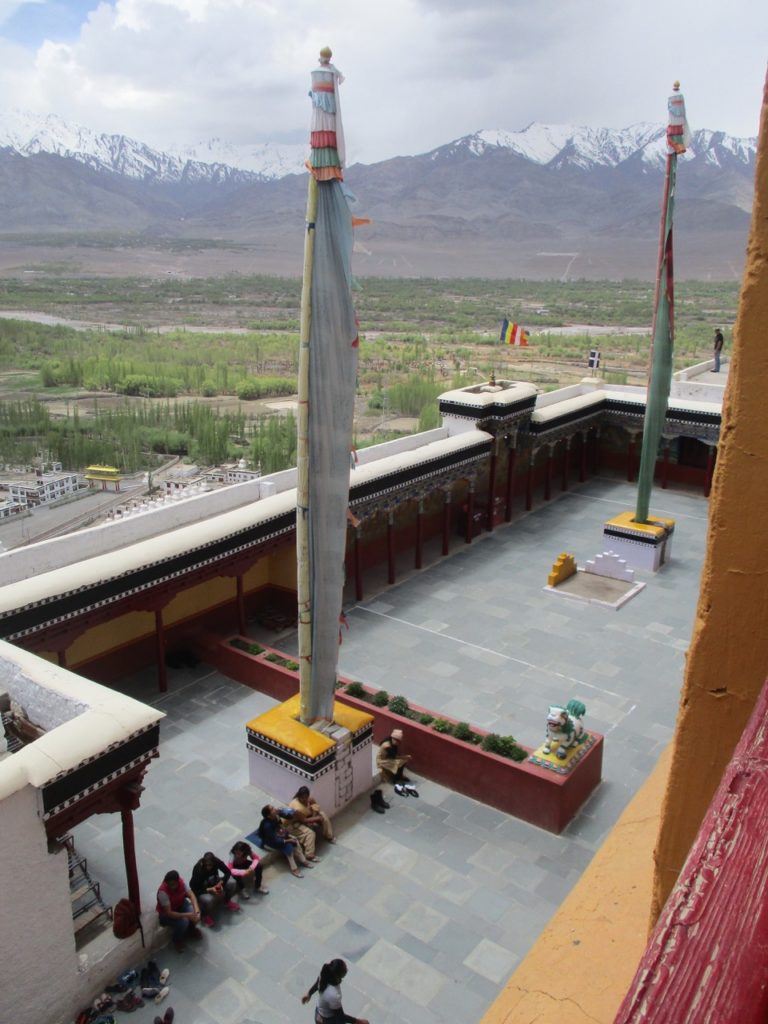
The courtyard and mountains surrounding Thiksey
Our work in Ladakh was based particularly at Thiksey Monastery, although we were lucky enough to visit several other Buddhist monasteries (Gompas) during our two week research period in May 2017, which saw us traverse well over 700 miles through deep snowy, moon-like Himalayan terrain and contrasting lush green lands of apricot trees, driving over several mountain passes (including the infamous Khardung-La), overcoming altitude and travel sickness, and even bouncing through a river bed, safely driven by the brilliant, Tundup (Jigmat Chosgyal) and guided by the excellent Chamba Tsetan (also Indian men’s ice hockey team international striker!). Monasteries we visited during this time included Hemis, Alchi, Likir, Diskit, Turtuk, Sumur, Tangtse, Stok, and Leh (have I forgotten any?!). We stayed in some incredible home stays during our time and met some wonderful hosts. In fact, it was perhaps through our conversations with the people that we met, that we learned most.
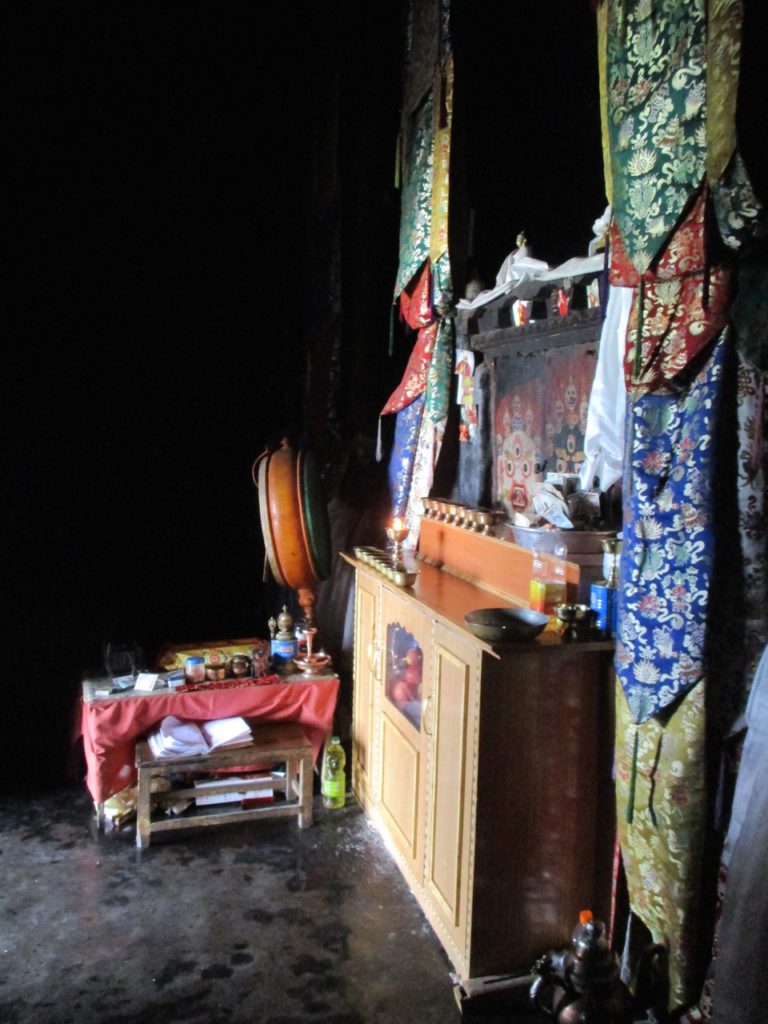
The Protector Temple
Researchers from the project had visited Thiksey initially on a phase of the research in 2016, but this post explores a second visit that occurred in May 2017, with just a small group – Professor Sandra Dudley, Oonagh Quigley and me, all of us from the University of Leicester. While many of the monasteries we visited, including Thiksey and Hemis, have museums, the research moved away from looking at what it is that objects do in museum contexts, to exploring a much wider landscape: what it is that objects are doing within a religious setting, and when the monasteries themselves are also doing something so unique, but for so many different constituencies. There were not many visitors in actual fact, visiting the museum parts of the monasteries, with most just exploring the different prayer halls and sacred spaces. (We had a very similar experience when researching in Ely Cathedral in the UK.) As with other phases of the research, we used mixed methods to gather our data – these included observational notes, sketches, sound recordings, photographs and conversations with monks and occasionally with other visitors. But perhaps here, my own notes became much more autoethnographical: reflections on what I was doing, what the research was for me, and my own sensory overload and responses to things.
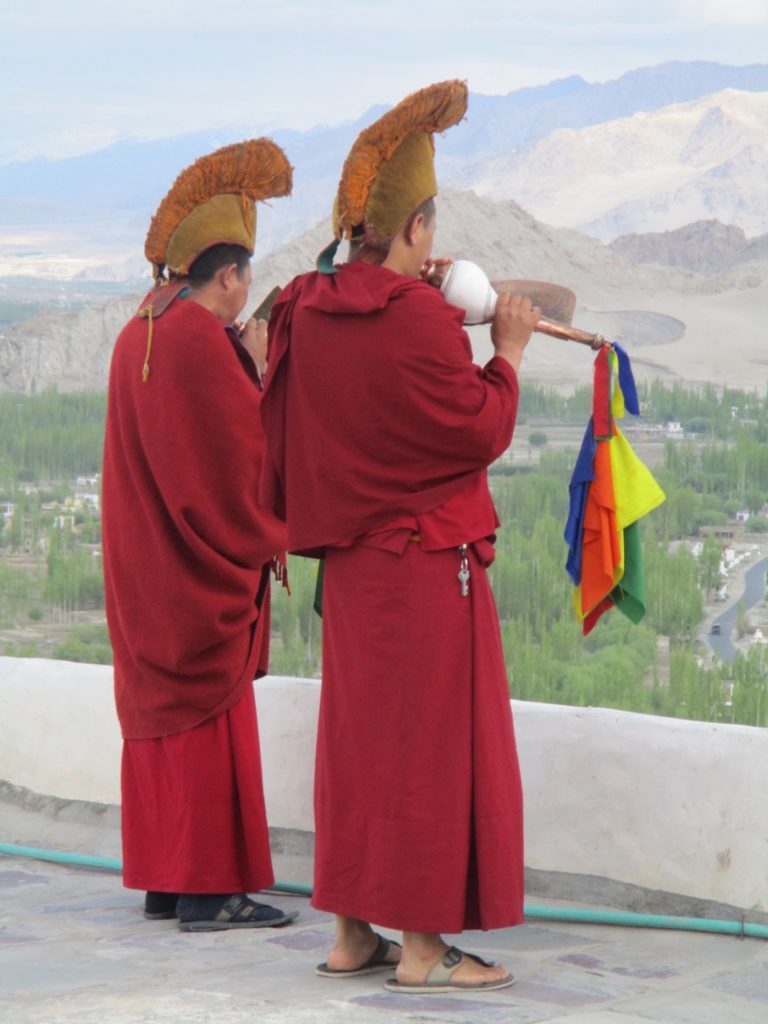
The conch trumpets welcoming the morning
I could write about many things that the trip left with me: the ‘conflicts’ between the Buddhist communities going about their daily lives, while dealing with the daily onslaught of (mostly Indian) tourists – and often alas disrespectful tourists at that. I could write about the impact that tourism is having in Ladakh, in a land where there is not enough water, and where consequently plastic (bottle) waste and the installation of western-style toilets for tourists is tearing apart the natural environment. I could write about the exciting ways in which Ladakhi heritage and traditional crafts are being re imagined and developed in new ways (for example the soft ‘French-style’ yak cheese of Norbu). I could talk about so many curious juxtapositions – even in the landscape itself – permanence and impermanence, serendipitous moments, friendships made.
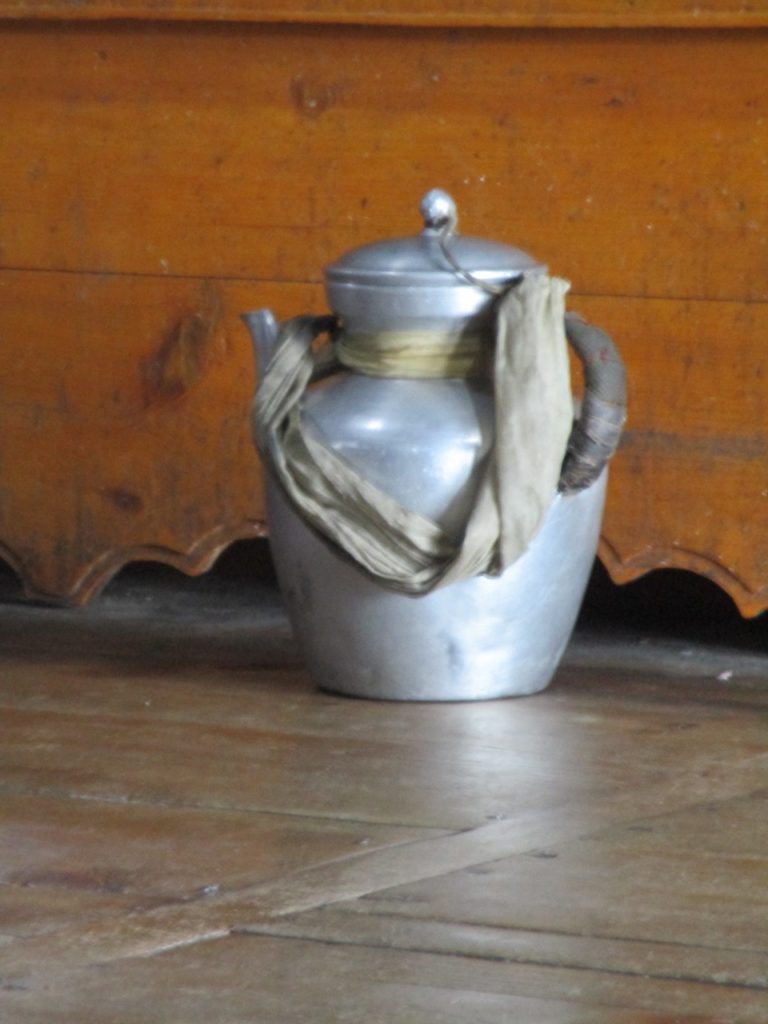
Butter tea teapot
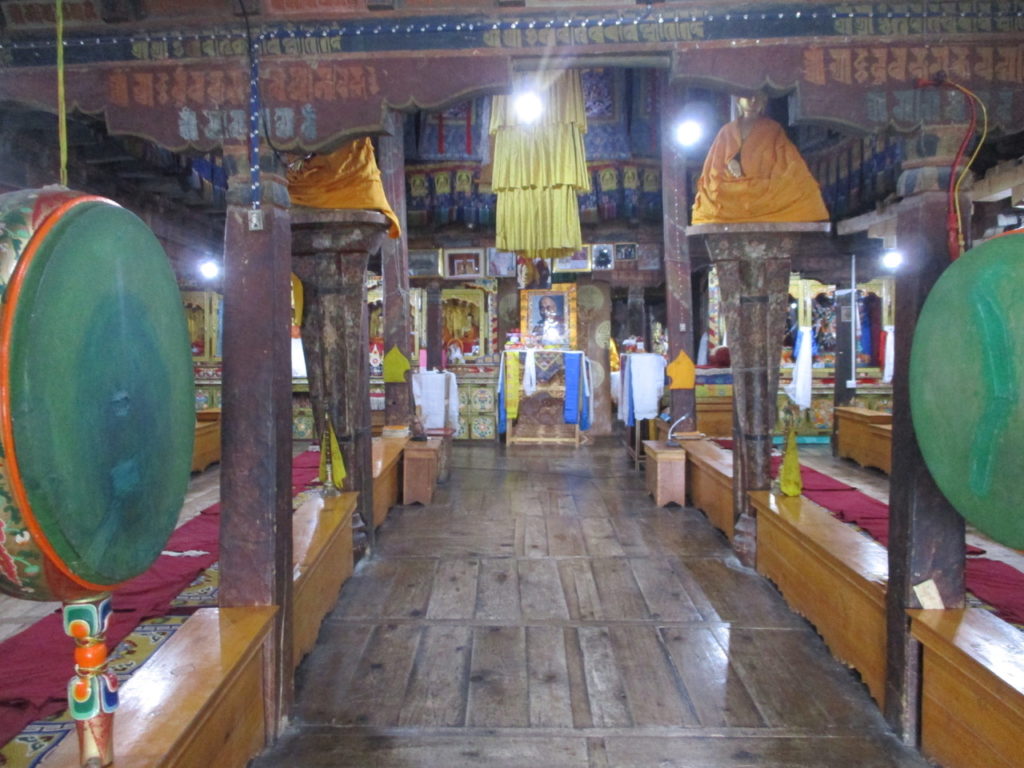
The Prayer Hall
But for now, I will just paint a picture of one particular encounter. Chamba Tashi, the monk ‘with the friendliest eyes and smile’ invites us to share in the morning prayers at Thiksey. I wake two minutes before my alarm clock, at 0458, getting ready to leave the guesthouse at 0530. We arrive at the monastery and ours is the only car in the carpark. Up the steps, past the prayer wheels. There is chanting coming from Chamba Tashi in the Protector Temple. After his prayers, Chamba Tashi greets us once he has finished his chanting. And then we can hear it: trumpeters up on the roof, welcoming the new day. Three blows of the conch horn. A pigeon flies overhead. Young monks are singing outside the prayer hall before entering. Cymbals and drums inside. And then we go into the prayer hall for morning prayer. We sit quietly at the back as the monks came in: all ages. The little ones are messing about, being told off. The space that had, up until this point, been animated by monks as tour-guides, and by tourists, is now truly alive. Its objects come alive. The drum. The pages of scriptures. The slow, repetitive, hypnotic, bass chanting – but sometimes with each reading at a different pace. The butter tea in huge teapots offered to all. That warm, strange, sweet, salty taste of comfort. The mixing of the ngampe flour into the tea to make a breakfast porridge. The unfamiliar familiar smells. The friendship and hospitality of a shared morning awakening.
What do all these sensory encounters mean? This is a question to which I return time and again. And I hope, quite literally, to return again.
 Dr Alexandra Woodall (Norwich, UK) is an experienced museum and gallery interpretation practitioner, researcher, teacher and consultant. She is particularly interested in how people encounter objects. Until recently she was Head of Learning at the Sainsbury Centre for Visual Arts (University of East Anglia, UK), and has previously worked for institutions including Royal Armouries, Manchester Art Gallery, Museums Sheffield and Kettle’s Yard, Cambridge. www.alexwoodall.co.uk @alexwoodall
Dr Alexandra Woodall (Norwich, UK) is an experienced museum and gallery interpretation practitioner, researcher, teacher and consultant. She is particularly interested in how people encounter objects. Until recently she was Head of Learning at the Sainsbury Centre for Visual Arts (University of East Anglia, UK), and has previously worked for institutions including Royal Armouries, Manchester Art Gallery, Museums Sheffield and Kettle’s Yard, Cambridge. www.alexwoodall.co.uk @alexwoodall
All pictures are taken by the author.
ReReeti works with museums, galleries and heritage sites across India to plan strategies, design systems and implement programmes to increase audience engagement and institutional/ company visibility. Email us at info@rereeti.org for a free consultation or to collaborate on an upcoming exhibition.







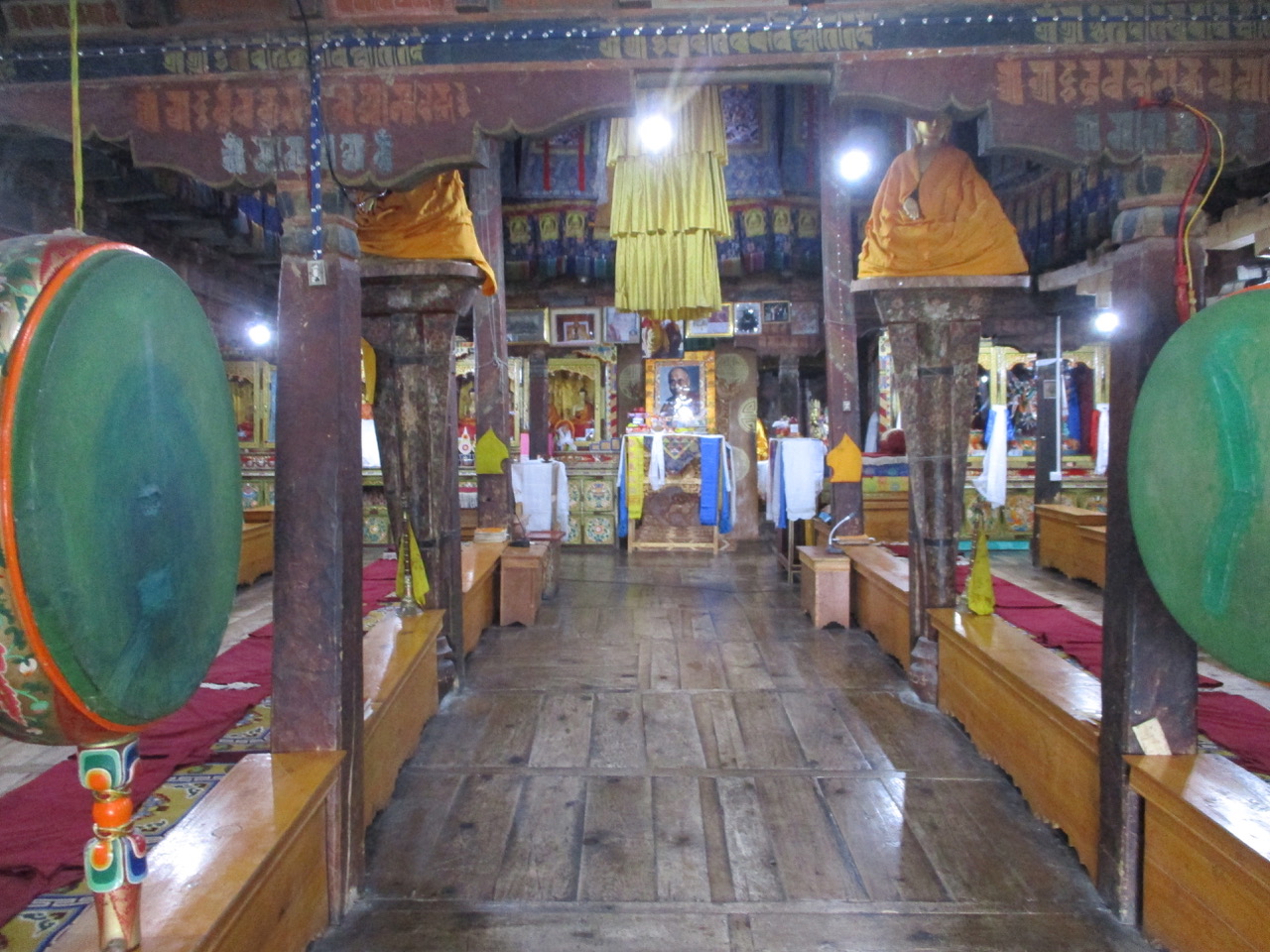
Recent Comments